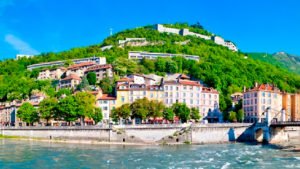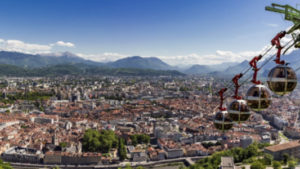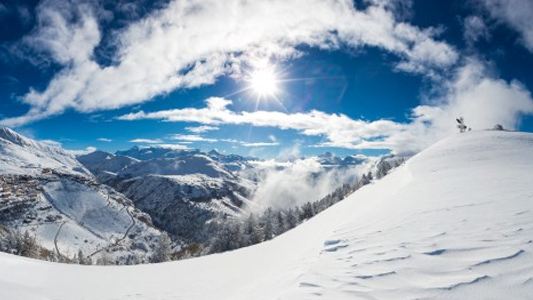- Home
- Institut Néel
- Research teams
- Technical Groups & Services
- Work at the Institut
- Partnerships

The musée de Grenoble, created in 1798, offers a broad spectrum of art works, ranging from the ancient and old to the modern and contemporary. There are over 25 000 artworks exposed, of which the great majority is presented only temporarily, with around 900 works displayed in the permanent gallery. The museum is around 14 000 m² divided through 57 separate rooms.
A visit through the museum’s galleries allows us to delve into the world of Western painting, ranging from the 13th to the 21st century with artworks of true historical importance: The great works of the Flemish, Dutch, Italian, and Spanish classical painters. In addition to this, the museum offers one of the richest and most diverse 20th century art collections around Europe. Finally, the inclusion of ancient Egyptian works, studied and documented by Champollion during his stay in Grenoble, prove the mere quality, wealth, and versatility offered by Grenoble’s Museum.
Contact information:
Musée de Grenoble
5, place Lavalette 38000 Grenoble
Phone: +33 4 76 63 44 44
musee-de-grenoble@grenoble.fr

© Musée de Grenoble
The Bastille is a symbolic element of Grenoble’s landscape, bearing great historical significance.
Originally constructed as a military fort during the 19th century, it was built on top of a hill named “the Bastille”, after which it was named. Overlooking a vast part of the city, it’s easily accessible thanks to a cable car departing from the heart of the city. To this day, over 600 000 individuals discover this site every single year, making it the most visited location in the area. There are many activities to be done at the Bastille, including Museums, escape games, via ferrata, zipline courses, restaurants, and many other services that make the Bastille a unique location to visit all throughout the year.
The Bastille is also classed as a zone of ecological interest for its diverse fauna and flaura, in addition to the Mediterranean vegetation found in its whereabouts.
For more information, click here

© images-et-reves
Grenoble’s cable car is one of the very first urban cable cars ever created, being the third after Rio de Janeiro and Cape Town. It was in 1934 that a touristic cable car was built. More than 24 million people have used it since its creation, and it yearly averages 300 000 users and remains open for over 4000 hours.
For more information, click here

© Lucas Frangella
There are 4 easily accessible ski stations near Grenoble: Lans-en-Vercors, Les 7 Laux, Chamrousse, and l’Alpe d’Huez. These resorts are all accessible via public transport and by car.
Lans-en-Vercors is one of the entry points to the regional park of the Vercors, which makes this town a family destination. With the ski domain spreading itself between 1000 and 1938 meters in altitude, Lans-en-Vercors offers a great place for beginners to learn, merging small size and some accessible ski runs. But it also offers more challenging slopes for those with more experience. Overall, this town offers all the benefits of being in the mountains while being 30 minutes away from Grenoble.
Les 7 laux is another great skiing location, being the biggest resort in the Belledonne mountain range with a huge size of 1500 Hectares of which 30 are groomed and secured. With altitudes ranging between 1350 and 2400 meters, this ski station offers slopes for all ski levels, and is the perfect place to go for intermediate and confirmed skiers who want to put their skills to the test. Beginners can also find many slopes to practice on thanks to the sheer size of the domain. The station itself is about 45 minutes away.
Chamrousse finds itself at the height of the Belledonne mountain range, 30 km away from Grenoble. Spread over 1300 hectares, it spans through multiple altitudes, starting at 1650 meters and going all the way up to the croix de Chamrousse 2250 meters high, Chamrousse offers a similar skiing experience to the 7 laux, with slopes for all levels.
L’alpe d’Huez is found on a pleateau, and is situated on a glacier. This ski station offers many different ski levels, and when at the summit of the mountain, if it’s sunny, it’s possible to see 1/5th of France all at once.
We advise all skiers who have under a year of practice in skiing or have never skied to take lessons! Skiing can be an incredibly dangerous sport if one does not know or understand how to do so safely. There are different organisms that give ski lessons in many nearby resorts, including lessons given in English.
For lessons taught in English, click here to learn more about the école de ski internationale
For lessons taught in French, click here to learn more about the ESF
 © LAURENT SALiNO / ALPE D’HUEZ TOURISME
© LAURENT SALiNO / ALPE D’HUEZ TOURISME
The Grenoble area has a large and efficient public transit system. The TAG (Transporation of the Grenoble Agglomeration) has over 500 km of coverage to offer. In total, that adds up to 44 bus lines and 5 tram lines.
TAG tickets are valid in all TAG buses and trams for a duration of one hour once your ticket has been validated by a machine (inside the bus or on the tram platform). They can be purchased at tram stops, inside buses, local merchants, or in TAG stores, costing at most 2.10 €.
For instant access to a valid ticket through your phone, you can text “1h” to the number “93123” and get an immediate confirmation number which acts as a validated ticket (This option is only fuctional if your phone carrier is one of the following: Bouygues télécom, Orange, SFR, or Free mobile). You will be charged the amount displayed in your confirmation ticket to your phone bill.
From Grenoble’s train station, the B tram line (in the direction of Genoble Oxford) will take you straight to the CNRS campus (that is next to the terminal, the “Oxford” stop).
To get to the laboratory by bus, the C6 lines (from Saint-Martin-d’Hères) and the n°22 (from Saint-Égrève)
www.tag.fr
When outside of the Grenoble area, the departmental buses of the Transisère network, even to get to the ski stations.
www.transisere.fr/en
And to consult your travels through the region, the website www.oura.fr is where you should go (How to travel through the Auvergne-Rhône-Alpes region, prices, buying tickets…)
A quick, ecological, and economical alternative remains bike riding. It’s one of the most coveted means of transport in the area due to the large amount of traffic generated within the city, and also due to the 320 km of bycicle roads set up throughout the city!
Métrovélo offers multiple models that you can rent for a day, a week, a month, a trimester, or even for a year (their shop is close to the CNRS campus).
www.metrovelo.fr
Whichever transportation service you use, TAG, TransIsère, train, or Métrovélo, don’t forget to get a subscription, your employer will help you pay your transit fees to get to work, at a minimum of 50% of the sum payed.
The Presqu’île de Grenoble, formerly known as the “scientific polygon”, is a center of scientific excellence located north of the city, at the confluence of two rivers: the Drac and the Isère. It has undergone a real revival in the last ten years! Just a stone’s throw from the laboratory, this attractive and lively neighborhood is now home to innovative buildings and some 30 shops.
Restaurants
Cuisinons maison
Ankka
Dubble
Crepes N’Shakes
Local shops
Carrefour Express
Paul Boulangerie-sandwicherie
Health
Pharmacie du Caducée
Centre de Santé Presqu’île
Transport
Métrovélo park presqu’ile
